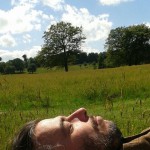Live Coding in Music
Live Coding in Music
Live coding allows composer’s to alter the architecture of structural elements through parametric design in response to audio-visual input/output.
Living coding in Music:
– graphic score-in-motion
– symbolic association for sound
– spatial field
Types of motion:
– Generative instance/gesture to produce multiple of outcomes.
Collaborative projects
Two collaborative projects were I applied live code to merge visual phenomena with instrumental and electroacoustic music to constantly respond to changing states of musical flux. Presenting two different forms of music that present unique challenges for composer and performers to ever changing ways of connectivity, flow of information and social-political networks.
1. Foreign Tongues (2015)
Invited by the instrumental composer Daniel Kidane to develop a graphical system to reflect the musical characteristics of his score Foreign Tongues an LSO commissioned. The visuals were live coded to produce a sequence of iterative patterns to reflected the instantaneous dynamic changes of his music. Lines were created to represent geometric shapes that overlap and intersect with each other to reveal a dynamic sense of movement. The visual forms were inspired by the artwork of Russian constructivism artists Alexander Rodchenko and Lyubov Popova. The constructionist art movement provided an alternative way of making objects in order to replace traditional ideas of art with ideas of ‘construction’.
‘Foreign Tongues’ composed by Daniel Kidane (2015).
2. Visualisation of Richard Scotts ‘Several circles'(2013) the visual presents a kinesthetic way of using computer code to generate a real-time simulation. In this instance, a single arbitrary image is transformed beyond its original context using Fast Fourier Transformation (FFT) that is then mapped across a screen pixels of an array within a 3 dimensional virtual space.
